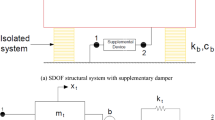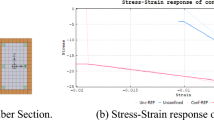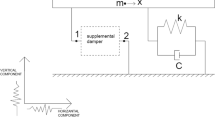Abstract
This paper describes an application of magneto- rheological (MR) grease dampers as seismic dampers for a three-story steel structure. MR fluid is widely known as a smart material with rheological properties that can be varied by magnetic field strength. This material has been applied to various types of devices, such as dampers, clutches, and engine mounts. However, the ferromagnetic particles dispersed in MR fluid settle out of the suspension after a certain interval because of the density difference between the particles and their carrier fluid. To overcome this defect, we developed a new type of controllable working fluid using grease as the carrier of magnetic particles. MR grease was introduced into a cylindrical damper, and the seismic performance of the damper was subsequently studied via numerical analysis. The analysis results of the MR grease damper were compared with those of other seismic dampers. We confirmed that the MR grease damper is an effective seismic damper.
Similar content being viewed by others
References
Takahashi O. Development and construction of three-dimensional seismic isolation building. In: Proceedings of 13th Japan Earthquake Engineering Symposium. 2010, 442–449 (in Japanese)
Kato R, Fujita S, Minagawa K, et al. Vibration damping of thermal power plant boiler due to earthquake by using viscous-friction hybrid dampers. In: Proceedings of Japan Society of Mechanical Engineers, Dynamics and Design Conference. 2015, 310 (in Japanese)
Yamano S, Matsuoka T, Hiramoto K, et al. Fluid inertia damper using MR fluid that has a long spiral by-pass pipe. In: Proceedings of Japan Society of Mechanical Engineers, Dynamics and Design Conference. 2015, 339 (in Japanese)
Komatsuzaki T, Iwata Y. Design of a real-time adaptively tuned dynamic vibration absorber with a variable stiffness property using magnetorheological elastomer. Shock and Vibration, 2015, 2015 (568): 1–11
Rabinow J. The magnetic fluid clutch. Transactions of American Institute of Electrical Engineers, 1948, 67(2): 1308–1315
Carlson J D, Catanzarite D M, St. Clair K A. Commercial magnetorheological fluid devices. International Journal of Modern Physics B, 1996, 10(23n24): 2857–2865
Ahn Y K, Ahmadian M, Morishita S. On the design and development of a magneto-rheological mount. Vehicle System Dynamics, 1999, 32(2–3): 199–216
Sodeyama H, Suzuki K, Iwata N, et al. A study on design method of the bypass type MR damper. Transactions of the Japan Society of Mechanical Engineers, Series A, 2004, 70(691): 625–632 (in Japanese)
Ahn Y K, Ha J H, Kim Y H, et al. Dynamic properties of a squeezetype mount using magnetorheological fluid. Proceedings of the Institution of Mechanical Engineers, Part K. Journal of Multi-Body Dynamics, 2005, 219(1): 27–34
Lee C H, Lee D W, Choi J Y, et al. Tribological characteristics modification of magnetorheological fluid. Journal of Tribology, 2011, 133(3): 031801
Shiraishi T, Miida Y, Sugiyama S, et al. Typical characteristics of magnetorheological grease and its application to a controllable damper. Transactions of the Japan Society of Mechanical Engineers, Series A, 2011, 77(778): 2193–2200 (in Japanese)
Jiang Z, Christenson R E. A fully dynamic magneto-rheological fluid damper model. Smart Materials and Structures, 2012, 21(6): 65002–65013
Cha Y J, Agrawal A K, Dyke S J. Time delay effects on large-scale MR damper based semi-active control strategies. Smart Materials and Structures, 2013, 22(1): 015011
Nagano Y, Nakagawa T, Suzuki K. A basic study for an elevator emergency stop device utilizing M.R. Fluid. In: Proceedings of the 15th International Conference on Electrical Machines and Systems. 2012, 1–4
Rahman M, Mahbubur Rashid M, Muthalif A G A, et al. Evaluation of different control policies of semi-active MR fluid damper of a quarter-car model, applied. Mechanics of Materials, 2012, 165: 310–315
Sugiyama S, Sakurai T, Morishita S. Vibration control of a structure using magneto-rheological grease damper. Frontiers of Mechanical Engineering, 2013, 8(3): 261–267
Japan Society of Tribologist. Basic Knowledge of Grease and its Applications. Yokendo, 2007 (in Japanese)
Ohya Y, Miyamoto S, Morishita S, et al. Experimental study on visualization of grease flow. Journal of Japanese Society of Tribologists, 2011, 56(4): 248–255
Author information
Authors and Affiliations
Corresponding author
Rights and permissions
About this article
Cite this article
Sakurai, T., Morishita, S. Seismic response reduction of a three-story building by an MR grease damper. Front. Mech. Eng. 12, 224–233 (2017). https://doi.org/10.1007/s11465-017-0413-6
Received:
Accepted:
Published:
Issue Date:
DOI: https://doi.org/10.1007/s11465-017-0413-6




